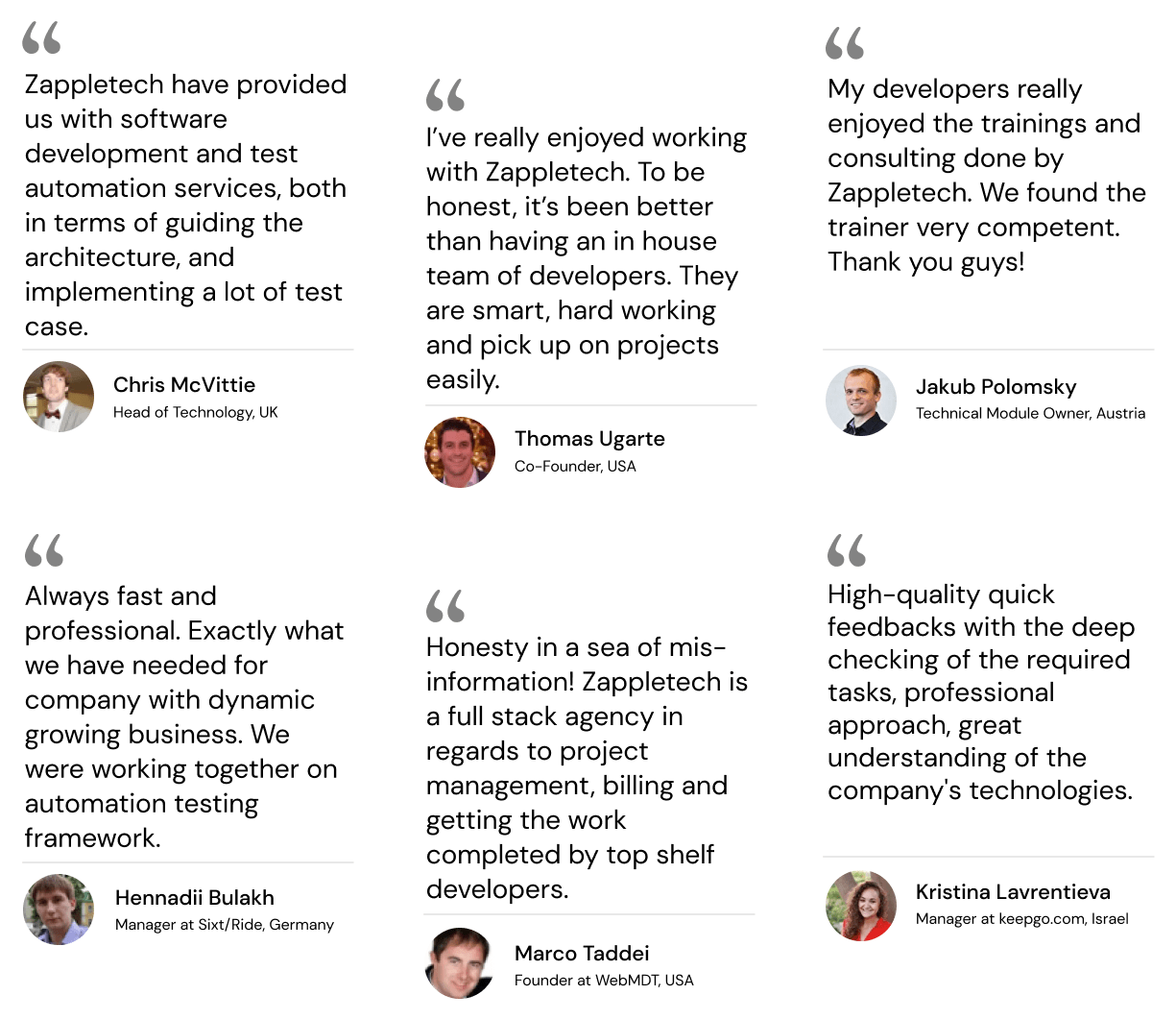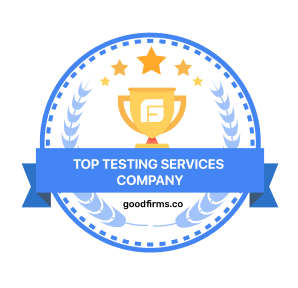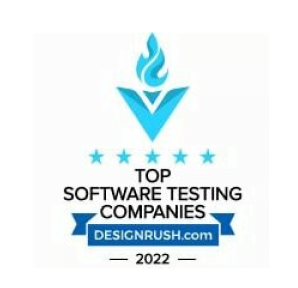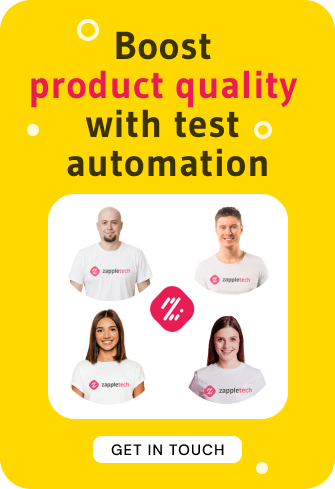Hire Test Automation Engineers


Why Should You Choose Us to Hire Test Automation Engineers?
When Do You Need to Hire Test Automation Engineers?
Industries We Work With
What Our Customers Say
Areas of Expertise for Our Test Automation Engineers
Our Expertise

The Process of Hiring Test Automation Engineers
Start Cooperation Now!

Why Should You Choose to Hire Test Automation Engineers?
Role of test automation engineers has emerged as indispensable. These professionals are pivotal in ensuring software products’ quality, reliability, and efficiency. As organizations strive to meet the ever-increasing demands of rapid development cycles and impeccable user experiences, test automation engineers become paramount.
- Driving Efficiency and Effectiveness: Test automation engineers specialize in developing, implementing, and maintaining automated testing frameworks and scripts. Organizations can significantly accelerate the testing process by leveraging their expertise while enhancing its accuracy and reliability. With manual testing often proving time-consuming and error-prone, hiring test automation engineers empowers teams to streamline their testing efforts and focus on delivering high-quality software within tight deadlines.
- Enabling Continuous Integration and Delivery (CI/CD): In the era of CI/CD pipelines, where the frequency of code deployments has surged, test automation engineers play a pivotal role in integrating automated tests seamlessly into the development workflow. By hiring test automation engineers, organizations can ensure that every code change undergoes rigorous testing automatically, thereby mitigating the risk of introducing bugs or regressions into the production environment. This integration of automated testing fosters a culture of continuous improvement and rapid iteration, enabling teams to deliver value to customers at an unprecedented pace.
- Enhancing Collaboration and Cross-functional Expertise: Test automation engineers act as catalysts for collaboration between development, quality assurance, and operations teams. By working closely with developers to understand the intricacies of the software architecture and design, hired test automation engineers can devise comprehensive automation strategies tailored to the specific needs of the project. Moreover, their proficiency in testing methodologies and tools enables them to bridge the gap between different stakeholders, fostering a cohesive and cross-functional approach to software development.
- Driving Innovation and Quality Assurance: As software systems’ complexity continues to evolve, so do the challenges associated with ensuring their reliability and performance. Test automation engineers bring a wealth of experience and expertise, enabling organizations to innovate rapidly while maintaining stringent quality standards. By hiring test automation engineers adept at leveraging cutting-edge technologies and best practices, organizations can stay ahead of the curve and deliver unparalleled value to their customers.
In conclusion, test automation engineers are instrumental in modern development teams, shaping the way software is built, tested, and delivered. By recognizing the importance of automation in driving efficiency, enabling continuous integration and delivery, fostering collaboration, and driving innovation, organizations can unlock new opportunities for growth and success. Therefore, the decision to hire test automation engineers is not just a strategic imperative but a catalyst for transformation in the competitive landscape of software development.
The Need for Test Automation Engineers
Manual testing, while essential, presents several challenges that can impede the efficiency and effectiveness of the testing process. These challenges include:
Time-Consuming Nature | Manual testing is inherently time-consuming, requiring testers to execute test cases manually and document the results meticulously. As software projects scale in complexity, the time, and effort required for manual testing increase exponentially, often leading to bottlenecks in the development lifecycle. |
Human Error | Manual testing is prone to human error, as testers may overlook critical test scenarios or make mistakes while executing test cases. These errors can result in undetected bugs slipping into production, leading to costly rework and potential customer dissatisfaction. |
Limited Test Coverage | Due to time and resource constraints, manual testing may not cover all possible test scenarios. Testers may prioritize certain areas of the application while neglecting others, leaving potential vulnerabilities undetected until later stages of development or even after deployment. |
Inconsistency | Manual testing relies on human judgment and interpretation, leading to inconsistencies in test execution and reporting across testers and testing cycles. This lack of consistency can hinder the reliability of test results and make it challenging to track and reproduce issues. |
Benefits of Test Automation
As clearly shown above, numerous virtues of test automation negate the difficulties associated with manual testing, making it a high-value proposition, especially for organizations that seek to enhance their testing process and develop excellent software products. These benefits include:
- Efficiency: Test automation helps slash the time and cost of testing by automating simple test cases that otherwise have to be executed manually. To enable this process, organizations have the opportunity to hire test automation engineers who will be able to write scripts for testing and thus speed up the process of testing and thus speed up the overall development cycles, which in return will lead to faster time to market and business agility.
- Accuracy: Automated tests run effectively and accurately and help to avoid the errors that might result from manual testing. An automation tester’s responsibility is to build, try, and test the automation testers to detect any minor variance from the expected program behavior, to help improve the test outcome accuracy, and reduce the chances of defects being released into the market.
- Scalability: In other words, when carried out as a test management strategy, test automation helps organizations increase testing capacity to meet evolving organizational needs. During automated testing, it becomes much easier for companies to hire test automation engineers to create new and more test cases, perform test case execution across one or more environments, and perform test parallelization that covers many applications without losing time or quality.
- Repeatability: First, automated tests can be run multiple times with a high level of reliability that will enable an organization to determine the quality, stability, and effectiveness of the delivered software within various builds, environments, and configurations. First, this repeatability increases the overall product quality because software changes are tested and retested before customer deployment, lowering the probability of bugs sneaking through the cracks and creating regressions.
- Cost-Effectiveness: One disadvantage of test automation results from a large amount of money specification for designing automated test scripts and the test automation framework required: Test automation saves more in the long run. Through decreasing costs of effort and time, minimizing the chances of defective products, and shortening time to market, the firms get an opportunity to manage their testing budgets properly and, in turn, improve on return on investment (ROI).
Key Responsibilities of Test Automation Engineers
Developing Automation Strategies
Test automation engineers are responsible for providing details about the vital aspects of the automation testing processes that need to be incorporated into the overall testing plans of the projects. When organizations staff their test automation engineer with skilled and experienced resources who understand the testing methodologies and tools, then the organization can benefit from the knowledge of the automation engineer by identifying areas where testing could greatly benefit from automation defining what test cases and areas should be automated. They can also decide on a strategy to automate the test life cycle. This is where test automation engineers work together with the stakeholders to coordinate him or and his or team with the stakeholders in a way that the automation effort is aligned with the objectives, time schedules, and resource availability of the project so that maximum ROI can be achieved from automated testing scenarios.
Creating and Executing the Test Cases via Automation
Another essential task of test automation engineers is to create automated testing scripts to ensure that the developed and purchased software applications can be tested with full efficiency for functionality, performance, and reliability. QA testers, also known as test automation engineers, make optimal use of the programming tools and testing frameworks to establish functional, efficient, and reliable testing scripts that imitate user interactions, validate the systems’ behavior, and identify any abnormalities before their release. In the context of test design and automation, they adhere to WDB, DTO, KDW, modularization, and other approaches to improve automated tests’ number, flexibility, and sustainability.
Integrating Automation into the CI/CD Pipeline
In the era of continuous integration and delivery (CI/CD), test automation engineers play a critical role in integrating automated tests seamlessly into the development workflow. By hiring test automation engineers proficient in CI/CD practices and tools, organizations can establish automated pipelines that trigger tests automatically upon code changes, integrate test results with build notifications, and provide timely feedback to developers. Test automation engineers collaborate with DevOps teams to configure and maintain CI/CD infrastructure, ensuring that automation remains an integral part of the software delivery process and contributes to the overall velocity and quality of releases.
Monitoring and Maintaining Automated Tests
Test automation engineers are responsible for monitoring the execution of automated tests, analyzing test results, and troubleshooting any issues that arise during testing. By hiring test automation engineers with strong analytical and problem-solving skills, organizations can proactively identify and address flaky tests, false positives, and other anomalies that may impact the reliability of automated testing. Test automation engineers also maintain and update automated test suites to accommodate changes in the application under test, the testing environment, or the business requirements, ensuring that automated tests remain relevant and effective throughout the software lifecycle.
Collaborating with Developers and QA Teams
Effective collaboration between test automation engineers, developers, and QA teams is essential for ensuring the success of automation initiatives. Hired test automation engineers actively engage with cross-functional teams to understand the software architecture, design, and requirements, align automation efforts with development priorities, and advocate for testability and quality throughout development. Test automation engineers collaborate with developers to integrate automated testing into the development workflow, provide guidance on writing testable code, and facilitate the adoption of testing best practices. They also collaborate with QA teams to share knowledge, resources, and tools, promote a culture of quality and continuous improvement, and collectively drive the success of automation projects.
In summary, the key responsibilities of test automation engineers encompass developing automation strategies, designing and implementing automated test cases, integrating automation into the CI/CD pipeline, monitoring and maintaining automated tests, and collaborating with developers and QA teams. By hiring test automation engineers with the requisite skills, expertise, and collaborative mindset, organizations can accelerate their automation efforts, enhance the efficiency and effectiveness of testing, and deliver high-quality software products that meet the needs and expectations of their stakeholders.
Skills and Qualifications of Test Automation Engineers
Proficiency in Programming Languages and Scripting
An effective test automation engineer must be well-versed in programming languages and scripting to write effective scripts for automated test cases. For instance, when recruiting test automation engineers, knowledge of automated testing languages such as Java, Python, C#, or JavaScript must be considered as it drives the organization towards following best practices and standardization. Software testing professionals as test automation engineers and developers, use their programming abilities to create tests, simulate test cases, work with user interfaces, and verify the performance of applications and systems to improve testing quality and increase productivity. Additionally, an understanding of scripting languages such as Selenium, Appium, or Robot ensures that test automation engineers can develop frameworks for automation testing that can support scalability and reusability, which is instrumental in integration testing.
Knowledge of Testing Frameworks and Tools
Test automation engineers possess in-depth knowledge of testing frameworks and tools to streamline the automation process and maximize test coverage. By hiring test automation engineers who are familiar with popular frameworks such as JUnit, TestNG, NUnit, or pytest, organizations can leverage existing automation solutions and frameworks to accelerate their testing efforts. Test automation engineers also have expertise in automation tools like Selenium WebDriver, Appium, or Cypress, enabling them to efficiently automate web, mobile, and desktop applications.
Additionally, knowledge of build tools like Jenkins, CI/CD pipelines, and version control systems such as Git is essential for integrating automated tests into the development workflow seamlessly.
Understanding of Software Development Methodologies
As for the laurels of test automation engineers, they know the SDM such as Agile, Scrum, and DevOps since they play an influential role in the proving methodology and its practices. By employing test automation engineers who quickly become acquainted with these methodologies, one can know that automation is developed harmoniously with development objectives, schedules, and goals. Test automation engineers work with the development team to incorporate automated testing into the CI/CD process and ensure that feedback is provided in a timely fashion, giving constructive feedback to the software developers promoted to the different phases and encouraging the right culture and approach to testing among developers. They understand that Agile principles allow test automation engineers to plan changes according to requirements, scramble efforts, and deliver great software products in equal cycles.
Analytical and Problem-Solving Skills
Test automation engineers possess strong analytical and problem-solving skills to identify, analyze, and troubleshoot issues encountered during testing. By hiring test automation engineers who excel in critical thinking, root cause analysis, and debugging, organizations can mitigate risks, address defects, and improve the reliability of automated tests. Test automation engineers leverage their analytical skills to interpret test results, diagnose failures, and optimize automated test scripts for performance and reliability. Moreover, their ability to think logically and systematically enables test automation engineers to design comprehensive test scenarios, validate complex system behaviors, and ensure the robustness and scalability of automated testing solutions.
Communication and Teamwork Abilities
Effective communication and teamwork are essential skills for test automation engineers to collaborate effectively with cross-functional teams and stakeholders. Organizations can foster collaboration, transparency, and knowledge sharing across development, QA, and operations teams by hiring test automation engineers who excel in verbal and written communication. Test automation engineers communicate test results, progress updates, and strategies clearly and concisely, enabling stakeholders to make informed decisions and prioritize automation efforts accordingly. Moreover, their ability to work collaboratively in a team environment fosters a culture of accountability, innovation, and continuous improvement, driving the success of automation projects and contributing to the organization’s overall success.
In summary, the skills and qualifications of test automation engineers encompass proficiency in programming languages and scripting, knowledge of testing frameworks and tools, understanding of software development methodologies, analytical and problem-solving skills, and communication and teamwork abilities. By test automation engineers who possess these skills and qualities, organizations can build high-performing automation teams, accelerate their testing efforts, and deliver high-quality software products that meet the needs and expectations of their stakeholders.
Frequently Asked Questions:
Why should I select test automation engineers from Zapple Tech?
Assurance of QA services and test automation are our main work profiles. We have closed over 100 projects for clients all over the world during the whole period of the team’s existence. Our specialists are trained in advanced QA techniques, technology, and tools.
What are the main expertises of test automation engineers in your company?
We are not tied to a single industry or skill set, performing the full range of test automation and quality assurance work on digital products. With advanced tools and algorithms, we efficiently solve the most complex tasks and challenges in the development process.
What are the types of testing your experts provide?
The entire spectrum needed to maximize digital product quality: Functional Testing, Unit Testing, Integration Testing, Smoke Testing, Non-functional Testing, Performance Testing, Regression Testing, Keyword-driven Testing, and Data-driven Testing. We also implement other types of testing upon request, which can cover up to 100% of project tasks.
How much cost your services?
The price of the work depends on several factors: the scale and complexity of the project, the number and level of experts involved, the time needed to complete all tasks, and the tools and technologies used. On average, complex testing is estimated at 15-20% of the total cost of development. Hiring employees from the staff is calculated individually.
How long should I work with your experts?
Before the expiration of the cooperation agreement. It can be extended upon request or shortened if necessary. We do not withdraw our experts from third-party projects on our own initiative. As an exception, the contract may be terminated by agreement between the parties or in the event of a breach of contract by one of the parties.
How fast could we start cooperation?
As a rule, within a week after the application is submitted. The preparation process is very simple: discuss the details of the project, select the right candidate, verify skills (if requested), sign a hiring agreement, and integrate the expert into the team. The sooner you hire an expert, the sooner they will start working on the quality assurance of your digital product.
Should bespoke programming be replaced with a record/play tool?
If necessary, our specialist will perform a set of your tasks to confirm your skills. In order to provide you with the best possible service, we maintain a staff of experts with various experiences and skills. This way, we provide the best candidates for your development team with specialized industry knowledge.
Do you give some guarantees or provide a money-back policy?
Our rating and feedback from satisfied customers are a guarantee of quality. If the expert does not meet your expectations, we can replace them with another performer. If, after this rotation, you are dissatisfied with the cooperation – we will refund the money and terminate the cooperation.
Can I reject cooperation if your expert fails the project?
Yes, you can terminate the employment contract at any time, only if it is the fault of our specialist that your project has failed. All conditions of cooperation are written in the contract and fully indicate the possible reasons for its termination by both parties.
Can I hire multiple specialists at the same time?
Yes, we provide both personal and team hiring. In addition, we can fully cover the needs of your project by forming a team of performers. The integrated approach is considered the best because all participants are already coordinated and have experience working together.








